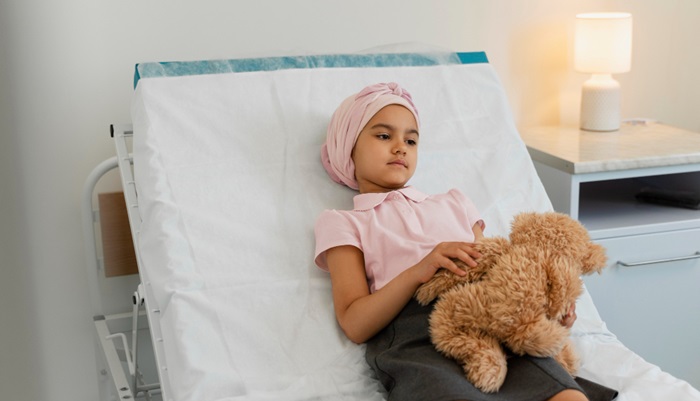Leukemia is one of the most frequently diagnosed cancers in children. This type of blood cancer is characterized by an increased number of abnormal white blood cells (leukocytes). Approximately 1 in 3 cases of cancer in children and adolescents is leukemia.
Childhood leukemia occurs when white blood cells (leukocytes) develop abnormally. Their aggressive growth eventually attacks other healthy cells, such as red blood cells and platelets, which are essential for overall health.
In addition to damaging healthy cells, these abnormal leukocytes fail to perform their function in fighting infections. This is why children with leukemia are more susceptible to recurring illnesses and other health issues.
Contents
Types of Leukemia in Children
There are several types of blood cancer. However, the most common types of leukemia in children are acute lymphoblastic leukemia (ALL) and acute myeloid leukemia (AML). Chronic leukemia is rare in children and adolescents and is more commonly found in adults.
-
Acute Lymphoblastic Leukemia (ALL)
ALL occurs when lymphocytes (a type of white blood cell) grow abnormally in the bone marrow. This is the most common type of leukemia in children, although adults can also develop it. The cancer can spread to the lymph nodes and central nervous system.
-
Acute Myeloid Leukemia (AML)
AML is more common in adults but is the second most common leukemia in children. The body contains different types of white blood cells, and AML leads to the abnormal growth of myeloblasts, red blood cells, and platelets.
Abnormal cell growth in acute leukemia progresses very rapidly, meaning a child’s health can deteriorate in a short period. However, early detection and appropriate treatment often improve survival rates.
Symptoms of Leukemia
The symptoms of leukemia in children are not significantly different from those in adults. Moreover, leukemia itself does not have distinctive symptoms.
Unlike other cancers that may cause lumps or tumors, blood cancer generally does not result in visible masses. Symptoms of leukemia can vary and may resemble those of other illnesses.
Common leukemia symptoms include:
- Fatigue or weakness
- Pale skin due to anemia
- Fever or chills
- Frequent nosebleeds, gum bleeding, or unexplained bruising
- Loss of appetite
- Unexplained weight loss
- Small red spots under the skin (petechiae)
Since leukemia symptoms can mimic other conditions, initial diagnoses may not immediately confirm leukemia. Several tests will be conducted to rule out other diseases.
If your child shows any of the symptoms above and you are concerned, consult a doctor immediately.
Causes of Leukemia
Bone marrow is a spongy tissue inside the bones responsible for producing various types of blood cells. Leukemia occurs when genetic mutations in the bone marrow cells cause them to divide uncontrollably, leading to an excessive number of abnormal cells.
Doctors and researchers have not yet determined the exact cause of genetic mutations in bone marrow cells. However, several factors may increase a child’s risk of developing leukemia, including:
- Having a sibling with leukemia, especially an identical twin
- Previous treatment with chemotherapy or radiation therapy
- Exposure to radiation
- Certain genetic conditions, such as Down syndrome, Li-Fraumeni syndrome, and neurofibromatosis type 1
Diagnosing Leukemia
Doctors usually begin with a medical history review and a physical examination to detect leukemia. However, these alone are not sufficient for diagnosis, so additional hematology tests and other examinations are required.
Common diagnostic tests for leukemia include:
- Blood tests, such as a complete blood count (CBC)
- Bone marrow aspiration and biopsy
- Genetic testing to detect chromosome and gene changes
Once leukemia is diagnosed, further tests may be conducted to determine its severity, including imaging scans and lumbar punctures.
Leukemia Treatment in Children
Early detection increases the chances of successful treatment and survival for children with leukemia. Treatment options depend on the type of leukemia and the child’s overall health condition.
-
Chemotherapy
The primary treatment for childhood leukemia is chemotherapy, which involves administering specific drugs to kill cancer cells.
Chemotherapy for childhood leukemia is typically very intensive during the first few months. About 95% of children with leukemia go into remission after one month of chemotherapy.
Once remission is achieved, ongoing chemotherapy is necessary to prevent cancer recurrence. Children may need chemotherapy for 2-3 years before being declared free of leukemia.
-
Radiation Therapy
If leukemia is severe or has spread to other organs (such as the brain), chemotherapy may be combined with radiation therapy, which uses high-energy radiation beams to destroy cancer cells.
-
Targeted Therapy
Targeted therapy is sometimes used to treat childhood leukemia. This treatment involves drugs that specifically target certain parts of cancer cells to eliminate them.
-
Stem Cell Transplant
If previous treatments are not sufficiently effective in managing childhood leukemia, a stem cell transplant may be an option.
Stem cells are essential for bone marrow function. A stem cell transplant involves implanting healthy donor stem cells into the child’s body, allowing damaged and destroyed blood-forming cells to regenerate and produce healthy blood cells.
Seeking Medical Treatment
With the right treatment, childhood leukemia is often curable. You can visit the Cancer Center at Royal Mandaya Hospital for medical consultation, diagnosis, and advanced cancer treatment options.
Schedule an appointment through WhatsApp Chat, Book Appointment, or the Care Dokter app, available on Google Play and the App Store, to facilitate your visit, check queue numbers, and access complete information.



